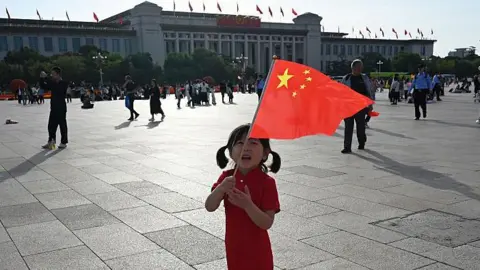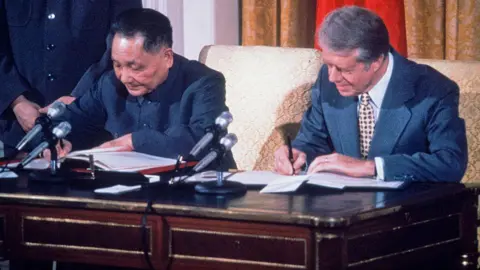China's Five Year Plans: Shaping the Global Economy

 AFP via Getty Images
AFP via Getty ImagesChina's top leaders are gathering in Beijing this week to decide on the country's key goals and aspirations for the rest of the decade.
Every year or so, the country's highest political body, the Central Committee of the Chinese Communist Party, convenes for a week of meetings, also known as a Plenum.
What it decides at this one will eventually form the basis of China's next Five Year Plan - the blueprint that the world's second largest economy will follow between 2026 and 2030.
The full plan won't come until next year, but officials are likely to hint at its contents on Wednesday and have previously given more details within a week of that.
Western policy works on election cycles, but Chinese policy making operates on planning cycles, says Neil Thomas, a fellow in Chinese politics at the Asia Society Policy Institute.
Five Year Plans spell out what China wants to achieve, signal the direction the leadership wants to go in and move the resources of the state towards these predefined conclusions, he adds.
On the surface, the idea of hundreds of suited bureaucrats shaking hands and drawing up plans may appear drab - but history tells us that what they decide often has huge repercussions for the world.
Here are three times China's Five Year Plan reshaped the global economy.
1981-84: Reform and Opening Up
Pinpointing exactly when China began its journey to become an economic powerhouse is difficult, but many in the Party like to say it was on 18 December 1978.
For nearly three decades, China's economy had been rigidly controlled by the state. But Soviet-style central planning had failed to lift prosperity and many were still struggling in poverty.
The country was still recovering from Mao Zedong's devastating rule. The Great Leap Forward and the Cultural Revolution - campaigns led by Communist China's founder to reshape the nation's economy and society - resulted in millions of deaths.
Speaking at the 11th Committee's Third Plenary Meeting in Beijing, the country's new leader Deng Xiaoping declared that it was time to embrace some elements of the free market.
His policy of reform and opening up became integral to the next Five Year Plan, which began in 1981.
The creation of free trading Special Economic Zones - and the foreign investment they attracted - transformed the lives of people in China.

 Getty Images
Getty ImagesAccording to Mr. Thomas, the aims of that Five Year Plan could not have been achieved more emphatically.
China today is beyond the wildest dreams of people in the 1970s, he says. In terms of restoring national pride as well as establishing its place amongst the great powers of the world, he says.
But it also fundamentally reshaped the global economy. By the 21st Century, millions of western manufacturing jobs had been outsourced to new factories in China's coastal regions.
Economists have called this the China shock and it's been one of the driving forces behind the rise of populist parties in former industrial parts of Europe and the United States.
For example, Donald Trump's economic policies - his tariffs and trade wars - are designed to bring back the American manufacturing jobs lost to China over the previous few decades.
2011-15: Strategic emerging industries
China's status as the workshop of the world was cemented once it joined the World Trade Organization in 2001. But at the turn of the century, the Communist Party leadership was already planning its next move.
It was wary of China falling into the so-called middle income trap. This happens when an upwardly mobile country can't offer ultra-low wages anymore, but at the same time doesn't have the innovative capacity to create the high-end goods and services of an advanced economy.
So instead of just cheap manufacturing, China needed to find what it called strategic emerging industries - a term first officially used in 2010. For China's leaders, this meant green technology, such as electric vehicles (EVs) and solar panels.
As climate change became increasingly important in Western politics, China mobilised an unprecedented amount of resources into these new industries.
Today, China is not only the undisputed world leader in renewables and EVs, it also has a near monopoly over the rare earth supply chains needed to build them.
China's stranglehold on these key resources - which are also crucial to chip-making and artificial intelligence (AI) - now puts it in a powerful position globally.
So much so that Beijing's recent move to tighten export controls on rare earths was labelled by Trump as an attempt to hold the world captive.
Although strategic emerging forces was enshrined in the next Five Year Plan in 2011, green technology had been identified as a potential engine of growth and geopolitical power by China's then leader Hu Jintao in the early 2000s.
This desire for China to be more self-reliant in its economy, in its technology, in its freedom of action, goes back a long way - it is part of the fibre of Chinese Communist Party ideology, explains Neil Thomas.
2021-2025: High quality development
This may explain why China's Five Year Plans more recently have turned their attention to high quality development, formally introduced by Xi Jinping in 2017.
This means challenging American dominance in technology and putting China at the forefront of the sector.
Domestic success stories such as the video sharing app TikTok, telecommunications giant Huawei and even DeepSeek, the AI model, are all testament to China's technological boom this century.
But western countries increasingly see this as a threat to their national security. The subsequent bans or attempted bans on popular Chinese technology have affected millions of internet users around the world and have sparked bitter diplomatic rows.




















